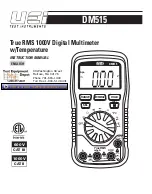
AD Instruments
_______________________________________________________________________________
©Copyright Abacanto Digital SA.
Manual de usuario AD6412
42
figure below:
Where: R
1
is the target grounding resistance.
R
0
is the equivalent resistance of the other entire tower grounding resistances
paralleled.
Although strictly on the theoretical grounding, because of the existence of so-called
"mutual resistanc
e”, R
0
is not the usual parallel value in the sense of electrical engineering
(slightly higher than its IEC parallel output value). But because a tower-grounding
hemisphere was much smaller than the distance between the towers, and with a great
number of locations after all, R
0
is much smaller than R
1
. Therefore, it can be justified to
assume R
0
=0 from an engineering perspective. In this way, the resistance we measured
should be R1.
Times of comparing tests in different environments and different occasions with the
traditional method proved that the above assumption is entirely reasonable.
2. Limited Point Grounding System
This is also quite common. For example, in some towers, five towers are linked with each
other through overhead ground wire; Besides, the grounding of some of the buildings is
not an independent grounding grid, but several grounding bodies connected with each
other through the wire.
Under such circumstances, the above R
0
regarded as 0, will yield more error on the
results of the measurement.
Due to the same reasons mentioned above, we may ignore the impact of the mutual
resistance; and the equivalent resistance of the grounding resistance paralleled is
calculated by the usual sense. Thus, for the grounding system of N (N is smaller, but
larger than 2) grounding bodies, it can offer N equations:
R
1
T
R
N
R
3
R
2
R
1
1
......
1
1
1
=
+
+
+
+
R
1
R
0
T
N
R
R
R
R
R
2
3
1
2
1
......
1
1
1
=
+
+
+
+




































